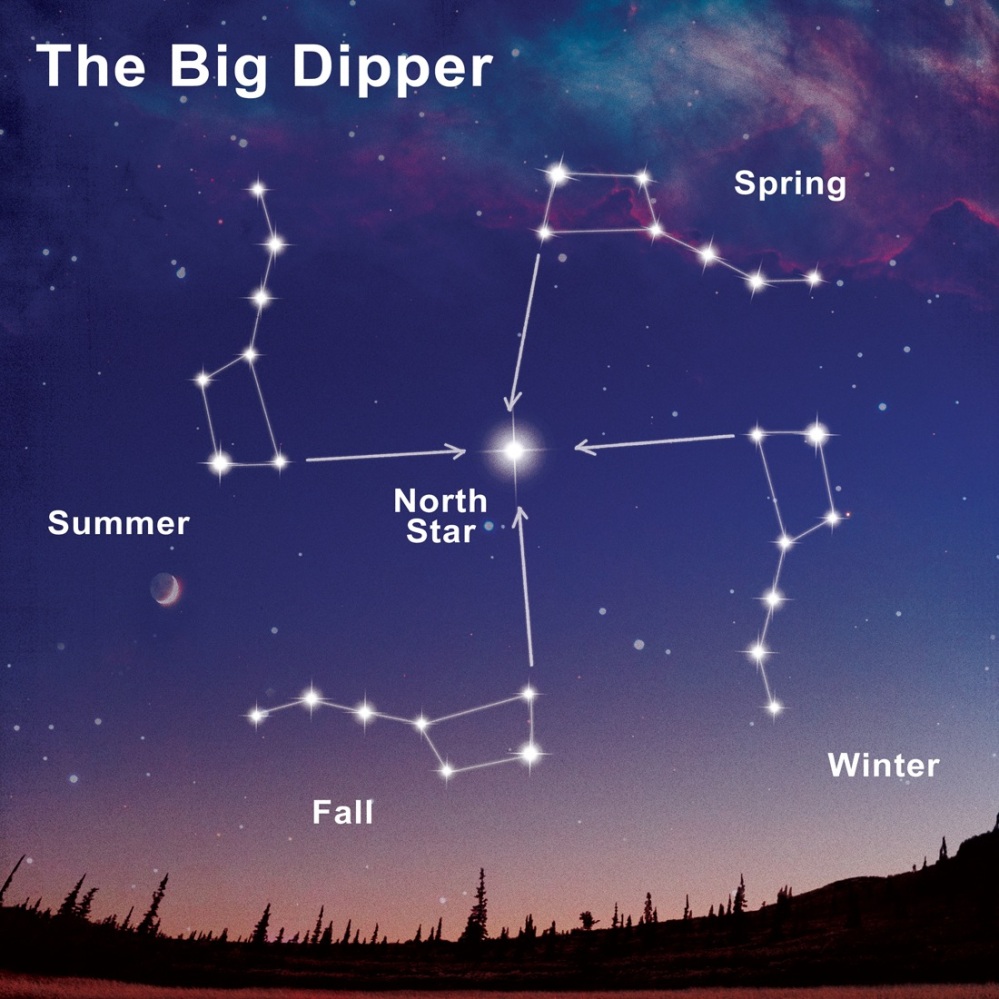
https://spiritualpunx.wordpress.com/2014/10/09/2014821the-big-dipper-a-swastika-perhaps-where-the-symbol-began-on-earth/
Ok, so swastika's aside for the moment, there is another thing of consequence.
There is a tentative link between the Big Dipper and Orions belt.
I was prompted to look at Orion's belt back in the winter months and saw how the pyramids at Giza were lined up with the constellation, and it appeared that the pyramids were a calendar of sorts suggesting time frames and events to occur in cycles.
We do not see Orions belt in our summer months, but the Big Dipper comes into view, it is the night time bunting of our northern hemisphere summers.
So a continuous map, clock and calendar, reminding us of the cyclic nature of earth. And it points out the paths in the skies, back to the heavens?
http://robertbauval.co.uk/articles/articles/cciae.html
Orions’s Belt
https://osr.org/blog/astronomy/pyramids-of-giza-and-orions-belt/
With precision and an eye to the sky, the great builders of the pyramids replicated Orion’s belt on the sands of Egypt. We know from old religious writings, that the ancient Egyptians believed that the gods descended from the belt of Orion. Furthermore, that Sirius (the brightest star in the sky) and these gods took the form of human beings. As a result, Orion became associated with the god Osiris. Sirius associated with the goddess Isis. Together they created all of the human civilization.
Their size and placement also take into account both the visible brightness and location of the stars within Orion’s belt. Consequently, the two larger pyramids line up perfectly in comparison to the smaller offset pyramid of Menkuare.
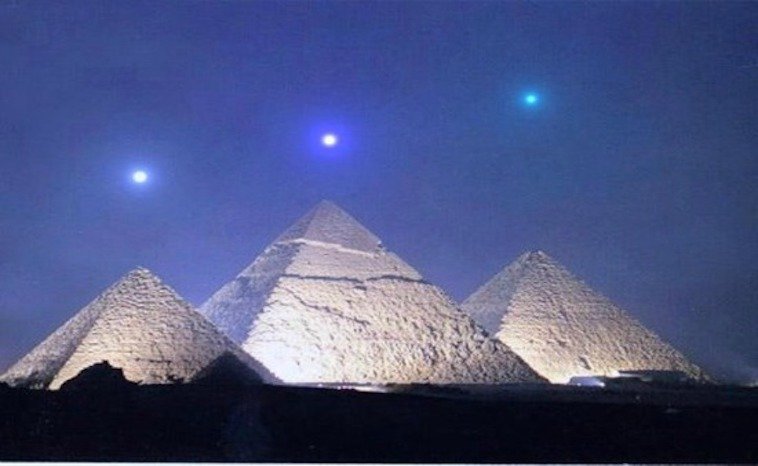
Axial Precision and Time
What about the movement of the stars due to axial precision? Axial precision refers to the gravity-induced, slow, and continuous change in the orientation of an astronomical body’s rotational axis. Furthermore, it cycles every 26,000 years. This is the phenomenon that alters the declination of all visible stars from Earth “Thus from its highest point at the meridian transit it takes the stars of Orion’s belt about 13,000 years to descend to the low point, last registered in 10,450 BC, that is immortalized in stone on the Giza plateau. As another 13,000 years pass, the belt stars very slowly rise again until the belt is back at 58 degrees again,; then during the next 13,000 years they gradually fall once more to the last point registered in 10,450 BC. This cycle is eternal: 13,000 years up, 13,000 years down, 13,000 years up, 13,000 years down, forever.”
Precision
Even with rudimentary instruments, the architects of the great pyramids managed to align the Great Pyramid to face true north. The position of the North Pole moved over time and the pyramid stayed exactly aligned. In fact, the east/west parallel that crosses the most land and the north/south meridian that crosses the most land intersect in two places on the earth, one in the ocean and the other at the Great Pyramid. While many believe there is a direct correlation between the constellation of Orion and the Pyramids at the Giza plateau, many people are unaware of the fact that the Descending Passage of the Great Pyramid pointed to the pole star Alpha Draconis, circa 2170-2144 BCE. This was the North Star at that point in time. No other star has aligned with the passage since then.
Big Dipper
The Big Dipper (US) or the Plough (UK)[1][2] is an asterism consisting of seven bright stars of the constellation Ursa Major;[3][4][5][6] six of them are of second magnitude and one, Megrez (δ), of third magnitude. Four define a "bowl" or "body" and three define a "handle" or "head". It is recognized as a distinct grouping in many cultures.
The North Star (Polaris), the current northern pole star and the tip of the handle of the Little Dipper (Little Bear), can be located by extending an imaginary line through the front two stars of the asterism, Merak (β) and Dubhe (α). This makes it useful in celestial navigation.
http://www.evolveandascend.com/2016/08/05/heard-lions-gate-ancient-egyptian-star-aligning-event-opening-august-8th/ASTROLOGY
Have You Heard of the Lion’s Gate? This Ancient Egyptian Star-Aligning Event is Opening August 8th
It is the Egyptian New Year, a time when Sirius rises in the sky and Orion’s belt aligns with the pyramids! If you are listening this is the perfect time to ignite your energy power generator!
For thousands of years, this time of year has been told to hold a huge influx of energy that comes through around August eighth of each year. This portal has been called the infinity portal or the Lion’s Gate, an energetic activation of the numbers 8/8, August: eighth month, in the sign of Leo the lion, on the eighth day of the year.
I like this version because today, 6th August, we are only days away from the Lions gate. for 2018, which astrologically and numerology generally means big things.
Maybe it is absolutely all of the above, which means we have massive signs going on all around us, all the time.
However, my favorite meaning is that In the UK it is known as the Plough. Adding this to the above gives
extra depth and dimension to the vision on my teacup.

'The starry plough'. Used by The Irish Republicans, https://en.wikipedia.org/wiki/Big_Dipper
The land is ploughed to make it ready for new seed. Maybe it is a constant reminder that there is work to be done to keep the land harvestable. Individually we cannot rest if we wish to maintain a constant upcycling and renewal of seeds to push human kind each step of the cyclic evolution.
Ploughing means that blades are pushed or pulled through to carve out and the upturn the land.
Michaela.
I like this version because today, 6th August, we are only days away from the Lions gate. for 2018, which astrologically and numerology generally means big things.
Maybe it is absolutely all of the above, which means we have massive signs going on all around us, all the time.
However, my favorite meaning is that In the UK it is known as the Plough. Adding this to the above gives
extra depth and dimension to the vision on my teacup.

'The starry plough'. Used by The Irish Republicans, https://en.wikipedia.org/wiki/Big_Dipper
The land is ploughed to make it ready for new seed. Maybe it is a constant reminder that there is work to be done to keep the land harvestable. Individually we cannot rest if we wish to maintain a constant upcycling and renewal of seeds to push human kind each step of the cyclic evolution.
Ploughing means that blades are pushed or pulled through to carve out and the upturn the land.
Michaela.
Plough
The primary purpose of ploughing is to turn over the upper layer of the soil, bringing fresh nutrients to the surface, while burying weeds and the remains of previous crops and allowing them to break down. As the plough is drawn through the soil it creates long trenches of fertile soil called furrows. In modern use, a ploughed field is typically left to dry out, and is then harrowed before planting. Ploughing and cultivating a soil homogenises and modifies the upper 12 to 25 cm of the soil to form a plough layer. In many soils, the majority of fine plant feeder roots can be found in the topsoil or plough layer.A plough (UK) or plow (US; both /plaʊ/) is a tool or farm implement used in farming for initial cultivation of soil in preparation for sowing seed or planting to loosen or turn the soil. Ploughs were traditionally drawn by working animals such as horses or cattle, but in modern times are drawn by tractors. A plough may be made of wood, iron, or steel frame with an attached blade or stick used to cut the soil and loosen it. It has been a basic instrument for most of recorded history, although written references to the plough do not appear in English until c. 1100 at which point it is referenced frequently. The plough represents one of the major agricultural inventions in human history.
Ploughs were initially human-powered, but the process became considerably more efficient once animals were pressed into service. The first animal-powered ploughs were undoubtedly pulled by oxen, and later in many areas by horses (generally draft horses) and mules, although various other animals have been used for this purpose. In industrialised countries, the first mechanical means of pulling a plough were steam-powered (ploughing engines or steam tractors), but these were gradually superseded by internal-combustion-powered tractors.

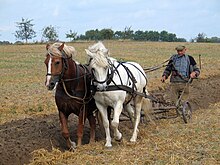
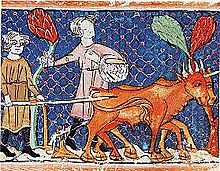
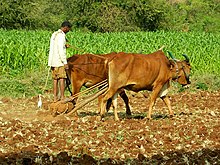
No comments:
Post a Comment
Note: only a member of this blog may post a comment.